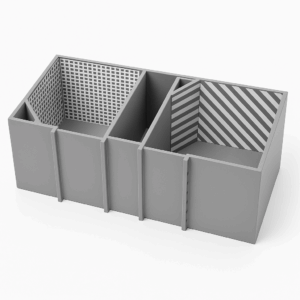$5,900.00 – $6,900.00Price range: $5,900.00 through $6,900.00
The rodent tremor monitor system from Maze Engineers serves to assess tremors in rodents, which are involuntary, rhythmic muscle contractions triggered by various factors. These include neurological conditions like stroke, multiple sclerosis, traumatic brain injury, or Parkinson’s disease; pharmacological issues such as mercury poisoning; and metabolic disturbances like hypoglycemia. This system is instrumental in diagnosing tremors definitively and monitoring their real-time response to treatment. It offers multiple chamber configurations with customizable specifications and dimensions.
Key parameters measurable with the rodent tremor monitor system include the type of tremor, its severity, and how it responds to treatment.
Here are some of the benefits of using a rodent tremor monitor system:

MazeEngineers empowers preclinical neuroscience research with meticulously designed, customizable behavioral apparatuses. From manual classic mazes to fully automated smart systems, we provide the tools scientists need to capture high-quality, reproducible data for studies on learning, memory, anxiety, and depression.


bool(false)

Mouse Features |
Sound attenuating chamber |
Mouse Enclosure |
Tremor Sensor |
Conduct software |
Rat Features |
Sound attenuating chamber |
Mouse Enclosure |
Tremor Sensor |
Conduct software |

Take advantage of Neuralynx, Ethovision Integration, SMS and Email integration with the Conductor Science Software. No I/O Boxes Required

The design of the Rodent Tremor Chamber integrates a sound-attenuating enclosure, rodent support apparatus, tremor detection sensor, and software suite for recording, analyzing, and exporting data.
Rodents modeled for tremors and control strains are securely positioned within the holder to facilitate precise tremor analysis.
For accurate rodent positioning, advanced video tracking software solutions like Noldus EthoVision, ANY-Maze, or BehaviorCloud can be utilized to monitor rodent movements within the chamber.
Set up protocol parameters using the Conduct software package, including experimental timing and other variables.
Introduce subjects into the rodent enclosure and provide a 10-minute habituation period.
Initiate tremor measurement using the Conduct software.
Record tremor frequencies and event counts, exporting the data to a PC for further analysis.
The following parameters can be measured using te rodent temor chamber:
The research aimed to explore the impact of harmaline, a naturally occurring compound, on tremor activity in mice. The investigators conducted experiments to assess harmaline’s tremor-inducing properties and to delve into the underlying mechanisms.
In the study, harmaline was administered to mice, and their tremor activity was monitored using specialized equipment. Significant increases in tremor activity were observed post-harmaline administration, affirming its ability to induce tremors.
To delve deeper into the mechanisms, various pharmacological agents were administered to the mice prior to harmaline dosing. This approach allowed researchers to evaluate how these agents influenced tremor activity. They focused on compounds targeting neurotransmitter systems like serotonin, glutamate, and GABA, all critical for motor control.
Results unveiled that some pharmacological agents exerted inhibitory effects on harmaline-induced tremor activity. For instance, serotonin-targeting compounds mitigated tremor intensity. Conversely, agents impacting the glutamate system intensified tremor activity.
The findings offer valuable insights into the pharmacological underpinnings of harmaline-induced tremors in mice. By scrutinizing how different compounds affect tremor severity, the study illuminates the intricate interactions among neurotransmitter systems crucial to motor function.
Overall, this research enhances comprehension of tremor disorders and may potentially guide the development of therapeutic strategies for conditions marked by aberrant tremor activity.
This study focuses on the discovery and identification of specific compounds, known as indole diterpenes, found in two plant species: Ipomoea asarifolia and Ipomoea muelleri. The study also investigates the biological activity of these compounds, particularly their ability to induce tremors.
The researchers conducted an extensive analysis of the chemical composition of the plants through various techniques, including chromatography and spectroscopy. They successfully isolated and identified several indole diterpenes from both Ipomoea asarifolia and Ipomoea muelleri.
Next, the researchers evaluated the tremor-inducing properties of these indole diterpenes. They administered the isolated compounds to laboratory animals and monitored their tremor activity using specialized equipment. The results demonstrated that these indole diterpenes indeed induced tremors in the animals, confirming their tremorgenic activity.
Furthermore, the study focused on a specific compound called 6,7-dehydro-11-hydroxy-12,13-epoxyterpendole A. The researchers isolated this compound and conducted detailed analysis to elucidate its chemical structure. By employing various spectroscopic techniques, they successfully determined the precise structure of 6,7-dehydro-11-hydroxy-12,13-epoxyterpendole A.
The discovery and identification of these tremorgenic indole diterpenes contribute to our understanding of the chemical diversity present in plants like Ipomoea asarifolia and Ipomoea muelleri. Additionally, the characterization of 6,7-dehydro-11-hydroxy-12,13-epoxyterpendole A provide a specific compound of interest for further investigations.
Overall, this research sheds light on the chemical properties and tremorgenic activity of indole diterpenes derived from Ipomoea asarifolia and Ipomoea muelleri. It may have implications in pharmacology and drug development, potentially leading to the discovery of new compounds or therapeutic strategies targeting tremor-related conditions.
The Rodent Tremor Chamber allows for ultra-sensitive measurements of tremor in rat and mouse models.
Gardner, D. R., Welch, K. D., Lee, S. T., Cook, D., & Riet-Correa, F. (2018). Tremorgenic Indole Diterpenes from Ipomoea asarifolia and Ipomoea muelleri and the Identification of 6,7-Dehydro-11-hydroxy-12,13-epoxyterpendole A. Journal of Natural Products, 81(7), 1682–1686. doi:10.1021/acs.jnatprod.8b00257
Paterson, N. E., Malekiani, S. A., Foreman, M. M., Olivier, B., & Hanania, T. (2009). Pharmacological characterization of harmaline-induced tremor activity in mice. European Journal of Pharmacology, 616(1-3), 73–80. doi:10.1016/j.ejphar.2009.05.031
| Species | Mouse, Rat |
|---|
There are no questions yet. Be the first to ask a question about this product.